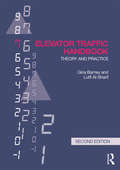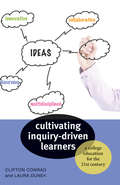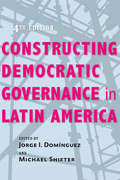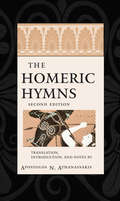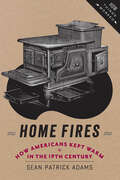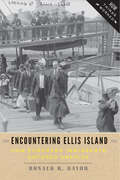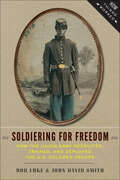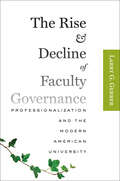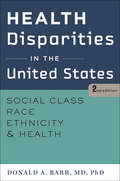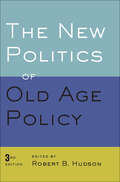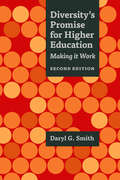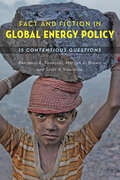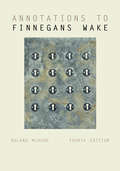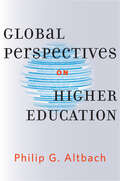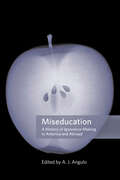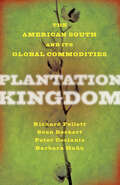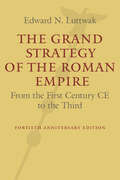- Table View
- List View
Elevator Traffic Handbook: Theory and Practice
by Gina Barney Lutfi Al-SharifThis second edition of this well-respected book covers all aspects of the traffic design and control of vertical transportation systems in buildings, making it an essential reference for vertical transportation engineers, other members of the design team, and researchers. The book introduces the basic principles of circulation, outlines traffic design methods and examines and analyses traffic control using worked examples and case studies to illustrate key points. The latest analysis techniques are set out, and the book is up-to-date with current technology. A unique and well-established book, this much-needed new edition features extensive updates to technology and practice, drawing on the latest international research.
Cultivating Inquiry-Driven Learners: A College Education for the Twenty-First Century
by Clifton Conrad Laura DunekInquiry-driven learners anticipate, embrace, and adapt to disruptive change. Clifton Conrad and Laura Dunek advance a transformative purpose of a college education. They invite stakeholders from across higher education to engage in vigorous dialogue about the aims of a college education—and how to realize those aims. Increasingly influenced by market forces, many universities employ a default purpose of a college education: preparing students for entry into the workforce. As a result, students remain unprepared for a world in which much of the knowledge they acquire will have a shelf life of only a few years.Cultivating Inquiry-Driven Learners charts a new way forward. It proposes that a college education prepare students to be innovative and adaptable by developing four signature capabilities: core qualities of mind, critical thinking skills, expertise in divergent modes of inquiry, and the capacity to express and communicate ideas. In concert, these capabilities empower students to explore and foster ideas that will prepare them to successfully navigate constant change, capitalize on career opportunities, enrich their personal lives, and thoughtfully engage in public life.This innovative book also explores a wide range of initiatives and practices for educating inquiry-driven learners. Examples illustrate possibilities for developing inquiry-driven learners across the curriculum and are drawn from institutions with remarkably different missions and identities—from research universities to liberal arts colleges.
Cultivating Inquiry-Driven Learners: A College Education for the Twenty-First Century
by Clifton Conrad Laura DunekInquiry-driven learners anticipate, embrace, and adapt to disruptive change. Clifton Conrad and Laura Dunek advance a transformative purpose of a college education. They invite stakeholders from across higher education to engage in vigorous dialogue about the aims of a college education—and how to realize those aims. Increasingly influenced by market forces, many universities employ a default purpose of a college education: preparing students for entry into the workforce. As a result, students remain unprepared for a world in which much of the knowledge they acquire will have a shelf life of only a few years.Cultivating Inquiry-Driven Learners charts a new way forward. It proposes that a college education prepare students to be innovative and adaptable by developing four signature capabilities: core qualities of mind, critical thinking skills, expertise in divergent modes of inquiry, and the capacity to express and communicate ideas. In concert, these capabilities empower students to explore and foster ideas that will prepare them to successfully navigate constant change, capitalize on career opportunities, enrich their personal lives, and thoughtfully engage in public life.This innovative book also explores a wide range of initiatives and practices for educating inquiry-driven learners. Examples illustrate possibilities for developing inquiry-driven learners across the curriculum and are drawn from institutions with remarkably different missions and identities—from research universities to liberal arts colleges.
Constructing Democratic Governance in Latin America (An Inter-American Dialogue Book)
by Jorge I. Domínguez Michael ShifterAfter more than a century of assorted dictatorships and innumerable fiscal crises, the majority of Latin America's states are governed today by constitutional democratic regimes. Some analysts and scholars argue that Latin America weathered the 2008 fiscal crisis much better than the United States. How did this happen? Jorge I. Domínguez and Michael Shifter asked area specialists to examine the electoral and governance factors that shed light on this transformation and the region's prospects. They gather their findings in the fourth edition of Constructing Democratic Governance in Latin America. This new edition is completely updated. Part I is thematic, covering issues of media, constitutionalism, the commodities boom, and fiscal management vis-à-vis governance. Part II focuses on eight important countries in the region—Argentina, Brazil, Bolivia, Chile, Colombia, Mexico, Peru, and Venezuela.Already widely used in courses, Constructing Democratic Governance in Latin America will continue to interest students of Latin American politics, democratization studies, and comparative politics as well as policymakers.
Constructing Democratic Governance in Latin America (An Inter-American Dialogue Book)
by Jorge I. Domínguez Michael ShifterAfter more than a century of assorted dictatorships and innumerable fiscal crises, the majority of Latin America's states are governed today by constitutional democratic regimes. Some analysts and scholars argue that Latin America weathered the 2008 fiscal crisis much better than the United States. How did this happen? Jorge I. Domínguez and Michael Shifter asked area specialists to examine the electoral and governance factors that shed light on this transformation and the region's prospects. They gather their findings in the fourth edition of Constructing Democratic Governance in Latin America. This new edition is completely updated. Part I is thematic, covering issues of media, constitutionalism, the commodities boom, and fiscal management vis-à-vis governance. Part II focuses on eight important countries in the region—Argentina, Brazil, Bolivia, Chile, Colombia, Mexico, Peru, and Venezuela.Already widely used in courses, Constructing Democratic Governance in Latin America will continue to interest students of Latin American politics, democratization studies, and comparative politics as well as policymakers.
The Homeric Hymns
by Erwin CookA rich source for students of Greek mythology and literature, the Homeric hymns are also fine poetry. Attributed by the ancients to Homer, these prooimia, or preludes, were actually composed over centuries and used by poets to prepare for the singing or recitation of longer portions of the Homeric epics. In his acclaimed translations of the hymns, Apostolos Athanassakis preserves the essential simplicity of the original Greek, offering a straightforward, line-by-line translation that makes no attempts to masquerade or modernize. For this long-awaited new edition, Athanassakis enhances his classic work with a comprehensive index, careful and selective changes in the translations themselves, and numerous additions to the notes which will enrich the reader's experience of these ancient and influential poems.
Home Fires: How Americans Kept Warm in the Nineteenth Century (How Things Worked)
by Sean Patrick AdamsHome Fires tells the fascinating story of how changes in home heating over the nineteenth century spurred the growth of networks that helped remake American society. Sean Patrick Adams reconstructs the ways in which the "industrial hearth" appeared in American cities, the methods that entrepreneurs in home heating markets used to convince consumers that their product designs and fuel choices were superior, and how elite, middle-class, and poor Americans responded to these overtures.Adams depicts the problem of dwindling supplies of firewood and the search for alternatives; the hazards of cutting, digging, and drilling in the name of home heating; the trouble and expense of moving materials from place to place; the rise of steam power; the growth of an industrial economy; and questions of economic efficiency, at both the individual household and the regional level. Home Fires makes it clear that debates over energy sources, energy policy, and company profit margins have been around a long time.The challenge of staying warm in the industrializing North becomes a window into the complex world of energy transitions, economic change, and emerging consumerism. Readers will understand the struggles of urban families as they sought to adapt to the ever-changing nineteenth-century industrial landscape. This perspective allows a unique view of the development of an industrial society not just from the ground up but from the hearth up.
Encountering Ellis Island: How European Immigrants Entered America (How Things Worked)
by Ronald H. BayorAmerica is famously known as a nation of immigrants. Millions of Europeans journeyed to the United States in the peak years of 1892–1924, and Ellis Island, New York, is where the great majority landed. Ellis Island opened in 1892 with the goal of placing immigration under the control of the federal government and systematizing the entry process. Encountering Ellis Island introduces readers to the ways in which the principal nineteenth- and early twentieth-century American portal for Europeans worked in practice, with some comparison to Angel Island, the main entry point for Asian immigrants. What happened along the journey? How did the processing of so many people work? What were the reactions of the newly arrived to the process (and threats) of inspection, delays, hospitalization, detention, and deportation? How did immigration officials attempt to protect the country from diseased or "unfit" newcomers, and how did these definitions take shape and change? What happened to people who failed screening? And how, at the journey's end, did immigrants respond to admission to their new homeland?Ronald H. Bayor, a senior scholar in immigrant and urban studies, gives voice to both immigrants and Island workers to offer perspectives on the human experience and institutional imperatives associated with the arrival experience. Drawing on firsthand accounts from, and interviews with, immigrants, doctors, inspectors, aid workers, and interpreters, Bayor paints a vivid and sometimes troubling portrait of the immigration process. In reality, Ellis Island had many liabilities as well as assets. Corruption was rife. Immigrants with medical issues occasionally faced a hostile staff. Some families, on the other hand, reunited in great joy and found relief at their journey's end. Encountering Ellis Island lays bare the profound and sometimes-victorious story of people chasing the American Dream: leaving everything behind, facing a new language and a new culture, and starting a new American life.
Soldiering for Freedom: How the Union Army Recruited, Trained, and Deployed the U.S. Colored Troops (How Things Worked)
by Bob Luke John David SmithAfter President Lincoln issued the final Emancipation Proclamation of January 1, 1863, Confederate slaves who could reach Union lines often made that perilous journey. A great many of the young and middle-aged among them, along with other black men in the free and border slave states, joined the Union army. These U.S. Colored Troops (USCT), as the War Department designated most black units, materially helped to win the Civil Warâ€�performing a variety of duties, fighting in some significant engagements, and proving to the Confederates that Northern manpower had practically no limits.Soldiering for Freedom explains how Lincoln’s administration came to recognize the advantages of arming free blacks and former slaves and how doing so changed the purpose of the war. Bob Luke and John David Smith narrate and analyze how former slaves and free blacks found their way to recruiting centers and made the decision to muster in. As Union military forces recruited, trained, and equipped ex-slave and free black soldiers in the last two years of the Civil War, white civilian and military authorities often regarded the African American soldiers with contempt. They relegated the men of the USCT to second-class treatment compared to white volunteers. The authors show how the white commanders deployed the black troops, and how the courage of the African American soldiers gave hope for their full citizenship after the war.Including twelve evocative historical engravings and photographs, this engaging and meticulously researched book provides a fresh perspective on a fascinating topic. Appropriate for history students, scholars of African American history, or military history buffs, this compelling and informative account will provide answers to many intriguing questions about the U.S. Colored Troops, Union military strategy, and race relations during and after the tumultuous Civil War.
The Rise and Decline of Faculty Governance: Professionalization and the Modern American University
by Larry G. GerberThe Rise and Decline of Faculty Governance is the first history of shared governance in American higher education. Drawing on archival materials and extensive published sources, Larry G. Gerber shows how the professionalization of college teachers coincided with the rise of the modern university in the late nineteenth century and was the principal justification for granting teachers power in making educational decisions. In the twentieth century, the efforts of these governing faculties were directly responsible for molding American higher education into the finest academic system in the world. In recent decades, however, the growing complexity of "multiversities" and the application of business strategies to manage these institutions threatened the concept of faculty governance. Faculty shifted from being autonomous professionals to being "employees." The casualization of the academic labor market, Gerber argues, threatens to erode the quality of universities. As more faculty become contingent employees, rather than tenured career professionals enjoying both job security and intellectual autonomy, universities become factories in the knowledge economy. In addition to tracing the evolution of faculty decision making, this historical narrative provides readers with an important perspective on contemporary debates about the best way to manage America’s colleges and universities. Gerber also reflects on whether American colleges and universities will be able to retain their position of global preeminence in an increasingly market-driven environment, given that the system of governance that helped make their success possible has been fundamentally altered.
Health Disparities in the United States: Social Class, Race, Ethnicity, and Health
by Donald A. BarrOutstanding Academic Title, Choice magazineThe health care system in the United States has been called the best in the world. Yet wide health disparities persist between different social groups, and many Americans suffer from poorer health than people in other developed countries. Donald A. Barr's Health Disparities in the United States explores how socioeconomic status, race, and ethnicity interact with socioeconomic inequality to create and perpetuate these health disparities. Examining the significance of this gulf for the medical community, cultural subsets, and society at large, Barr offers potential policy- and physician-based solutions for reducing health inequity in the long term.This popular course book, which has been fully updated, now incorporates significant new material, including a chapter on the profound effects of inequality on child development, behavioral choices, and adult health status. An essential text for courses in public health, health policy, and sociology, the second edition analyzes the complex web of social forces that influence health outcomes in the United States. This book is a vital teaching tool and a comprehensive reference for social science and medical professionals.
Health Disparities in the United States: Social Class, Race, Ethnicity, and Health
by Donald A. BarrOutstanding Academic Title, Choice magazineThe health care system in the United States has been called the best in the world. Yet wide health disparities persist between different social groups, and many Americans suffer from poorer health than people in other developed countries. Donald A. Barr's Health Disparities in the United States explores how socioeconomic status, race, and ethnicity interact with socioeconomic inequality to create and perpetuate these health disparities. Examining the significance of this gulf for the medical community, cultural subsets, and society at large, Barr offers potential policy- and physician-based solutions for reducing health inequity in the long term.This popular course book, which has been fully updated, now incorporates significant new material, including a chapter on the profound effects of inequality on child development, behavioral choices, and adult health status. An essential text for courses in public health, health policy, and sociology, the second edition analyzes the complex web of social forces that influence health outcomes in the United States. This book is a vital teaching tool and a comprehensive reference for social science and medical professionals.
The New Politics of Old Age Policy
by Robert B. HudsonAs the average age of the U.S. population continues to increase, age-related policies have come under intense scrutiny, sparking heated debates. In the past, older people were seen as a frail, dependent population, but major policies enacted or expanded on their behalf have made them major players in electoral and interest-group politics. This thoroughly revised and updated edition of Robert B. Hudson’s The New Politics of Old Age Policy not only explains the politics behind the country’s age-based programs and describes how those programs work but also assesses how wellâ€�or poorlyâ€�they meet the growing and changing needs of older Americans. Essays by leading experts in political science, sociology, law, social work, and gerontology address, among other things, theoretical approaches to age-based policy; population dynamics and the impact of growing diversity within the older population; and national, state, and local issues associated with major age-based programs. More than any other source, this book presents the most current information on growing older in the United States, including in-depth analyses of Social Security, Medicare, Medicaid, housing initiatives, the Older Americans Act, the Age Discrimination in Employment Act, and tax policy.Detailed new chapters focus on financial security and retirement in the context of the Great Recession, diversity and inequality in aging populations, and implications of the Affordable Care Act. Scholars, students, and policymakers will appreciate the volume’s timely overview of the evolution of aging policy.
Diversity's Promise for Higher Education: Making It Work
by Daryl G. SmithDaryl G. Smith has devoted her career to studying and fostering diversity in higher education. She has witnessed and encouraged the evolution of diversity from an issue addressed sporadically on college campuses to a reality of the modern university experience. In Diversity’s Promise for Higher Education, Smith brings together scholarly and field research relevant to the next generation of diversity work. The book argues that achieving excellence in a diverse society requires increasing the institutional capacity for diversity while simultaneously working to understand how diversity is tied to better leadership, positive change, research in virtually every field, student success, accountability, and more equitable hiring practices. To become more relevant to society, the nation, and the world while remaining true to their core missions, colleges and universities must continue to see diversityâ€�like technologyâ€�as central, not parallel, to their work. In Diversity’s Promise for Higher Education, Smith proposes a set of clear and realistic practices that will help colleges and universities locate diversity as a strategic imperative and pursue diversity efforts that are inclusive of the variedâ€�and growingâ€�issues apparent on campuses without losing focus on the critical unfinished business of the past.In this edition, which is aimed at administrators, faculty, researchers, and students of higher education, Smith emphasizes a transdisciplinary approach to the topic of diversity, drawing on an updated list of sources from a wealth of literatures and fields. The tables have been refreshed to include data on faculty diversity over a twenty-year period and the book includes new information about gender identity, stereotype threat, student success, the growing role of chief diversity officers, the international emergence of diversity issues, faculty hiring, and implicit bias.
Diversity's Promise for Higher Education: Making It Work
by Daryl G. SmithDaryl G. Smith has devoted her career to studying and fostering diversity in higher education. She has witnessed and encouraged the evolution of diversity from an issue addressed sporadically on college campuses to a reality of the modern university experience. In Diversity’s Promise for Higher Education, Smith brings together scholarly and field research relevant to the next generation of diversity work. The book argues that achieving excellence in a diverse society requires increasing the institutional capacity for diversity while simultaneously working to understand how diversity is tied to better leadership, positive change, research in virtually every field, student success, accountability, and more equitable hiring practices. To become more relevant to society, the nation, and the world while remaining true to their core missions, colleges and universities must continue to see diversityâ€�like technologyâ€�as central, not parallel, to their work. In Diversity’s Promise for Higher Education, Smith proposes a set of clear and realistic practices that will help colleges and universities locate diversity as a strategic imperative and pursue diversity efforts that are inclusive of the variedâ€�and growingâ€�issues apparent on campuses without losing focus on the critical unfinished business of the past.In this edition, which is aimed at administrators, faculty, researchers, and students of higher education, Smith emphasizes a transdisciplinary approach to the topic of diversity, drawing on an updated list of sources from a wealth of literatures and fields. The tables have been refreshed to include data on faculty diversity over a twenty-year period and the book includes new information about gender identity, stereotype threat, student success, the growing role of chief diversity officers, the international emergence of diversity issues, faculty hiring, and implicit bias.
Fact and Fiction in Global Energy Policy: Fifteen Contentious Questions
by Benjamin K. Sovacool Marilyn A. Brown Scott V. ValentineEnergy sustainability and climate change are two of the greatest challenges facing humankind. Unraveling these complex and interconnected issues demands careful and objective assessment. Fact and Fiction in Global Energy Policy aims to change the prevailing discourse by examining fifteen core energy questions from a variety of perspectives, demonstrating how, for each of them, no clear-cut answer exists.Is industry the chief energy villain? Can we sustainably feed and fuel the planet at the same time? Is nuclear energy worth the risk? Should geoengineering be outlawed? Touching on pollution, climate mitigation and adaptation, energy efficiency, government intervention, and energy security, the authors explore interrelated concepts of law, philosophy, ethics, technology, economics, psychology, sociology, and public policy.This book offers a much-needed critical appraisal of the central energy technology and policy dilemmas of our time and the impact of these on multiple stakeholders.
Fact and Fiction in Global Energy Policy: Fifteen Contentious Questions
by Benjamin K. Sovacool Marilyn A. Brown Scott V. ValentineEnergy sustainability and climate change are two of the greatest challenges facing humankind. Unraveling these complex and interconnected issues demands careful and objective assessment. Fact and Fiction in Global Energy Policy aims to change the prevailing discourse by examining fifteen core energy questions from a variety of perspectives, demonstrating how, for each of them, no clear-cut answer exists.Is industry the chief energy villain? Can we sustainably feed and fuel the planet at the same time? Is nuclear energy worth the risk? Should geoengineering be outlawed? Touching on pollution, climate mitigation and adaptation, energy efficiency, government intervention, and energy security, the authors explore interrelated concepts of law, philosophy, ethics, technology, economics, psychology, sociology, and public policy.This book offers a much-needed critical appraisal of the central energy technology and policy dilemmas of our time and the impact of these on multiple stakeholders.
Annotations to Finnegans Wake
by Roland McHughRoland McHugh’s classic Annotations to Finnegans Wake provides both novice readers and seasoned Joyceans with a wealth of information in an easy-to-use format uniquely suited to this densely layered text. Each page of the Annotations corresponds directly to a page of the standard Viking/Penguin edition of Finnegans Wake and contains line-by-line notes following the placement of the passages to which they refer, enabling readers to look directly from text to notes and back again, with no need to consult separate glossaries or other listings.McHugh’s richly detailed annotations distill decades of scholarship, explicating foreign words, unusual English connotations and colloquial expressions, place names, historical events, song titles and quotations, parodies of other texts, and Joyce’s diverse literary and popular sources. This thoroughly updated fourth edition draws heavily on Internet resources and keyword searches. For the first time, McHugh provides readers with a synopsis of the action of Finnegans Wake. He also expands his examination of possible textual corruption and adds hundreds of new glosses to help scholars, students, and general readers untangle the dense thicket of allusions that crowds every sentence of Joyce’s nearly inscrutable masterpiece.
Global Perspectives on Higher Education: A Global Revol (Global Perspectives On Higher Education Ser. #2)
by Philip G. AltbachOver the past half-century, globalization has had a profound impact on postsecondary education. The twin forces of mass higher education and the global knowledge economy have driven an unprecedented transformation. These fundamental changes have pulled in opposite directions: one pushes for wider access and accompanying challenges of quality, the other toward exclusive, "world class" research-oriented universities. In Global Perspectives on Higher Education, renowned higher education scholar Philip G. Altbach offers a wide-ranging perspective on the implications of these key forces and explores how they influence academe everywhere. Altbach begins with a discussion of the global trends that increasingly affect higher education, including the implications of mass enrollments, the logic of mass higher education systems around the world, and specific challenges facing Brazil, Russia, India, and China. He considers the numerous implications of globalization, including the worldwide use of the English language, university cross-border initiatives, the role of research universities in developing countries, the impact of the West on Asian universities, and the expansion of private higher education.Provocative and wide-ranging, Global Perspectives on Higher Education considers how the international exchange of ideas, students, and scholars has fundamentally altered higher education.
Global Perspectives on Higher Education
by Philip G. AltbachOver the past half-century, globalization has had a profound impact on postsecondary education. The twin forces of mass higher education and the global knowledge economy have driven an unprecedented transformation. These fundamental changes have pulled in opposite directions: one pushes for wider access and accompanying challenges of quality, the other toward exclusive, "world class" research-oriented universities. In Global Perspectives on Higher Education, renowned higher education scholar Philip G. Altbach offers a wide-ranging perspective on the implications of these key forces and explores how they influence academe everywhere. Altbach begins with a discussion of the global trends that increasingly affect higher education, including the implications of mass enrollments, the logic of mass higher education systems around the world, and specific challenges facing Brazil, Russia, India, and China. He considers the numerous implications of globalization, including the worldwide use of the English language, university cross-border initiatives, the role of research universities in developing countries, the impact of the West on Asian universities, and the expansion of private higher education.Provocative and wide-ranging, Global Perspectives on Higher Education considers how the international exchange of ideas, students, and scholars has fundamentally altered higher education.
Miseducation: A History of Ignorance-Making in America and Abroad
by A. J. AnguloIgnorance, or the study of ignorance, is having a moment. Ignorance plays a powerful role in shaping public opinion, channeling our politics, and even directing scholarly research. The first collection of essays to grapple with the historical interplay between education and ignorance, Miseducation finds ignoranceâ€�and its social production through naïveté, passivity, and active agencyâ€�at the center of many pivotal historical developments. Ignorance allowed Americans to maintain the institution of slavery, Nazis to promote ideas of race that fomented genocide in the 1930s, and tobacco companies to downplay the dangers of cigarettes. Today, ignorance enables some to deny the fossil record and others to ignore climate science. A. J. Angulo brings together seventeen experts from across the scholarly spectrum to explore how intentional ignorance seeps into formal education. Each chapter identifies education as a critical site for advancing our still-limited understanding of what exactly ignorance is, where it comes from, and how it is diffused, maintained, and regulated in society.Miseducation also challenges the notion that schools are, ideally, unimpeachable sites of knowledge production, access, and equity. By investigating how laws, myths, national aspirations, and global relations have recast and, at times, distorted the key purposes of education, this pathbreaking book sheds light on the role of ignorance in shaping ideas, public opinion, and policy.
Miseducation: A History of Ignorance-Making in America and Abroad
by A. J. AnguloIgnorance, or the study of ignorance, is having a moment. Ignorance plays a powerful role in shaping public opinion, channeling our politics, and even directing scholarly research. The first collection of essays to grapple with the historical interplay between education and ignorance, Miseducation finds ignoranceâ€�and its social production through naïveté, passivity, and active agencyâ€�at the center of many pivotal historical developments. Ignorance allowed Americans to maintain the institution of slavery, Nazis to promote ideas of race that fomented genocide in the 1930s, and tobacco companies to downplay the dangers of cigarettes. Today, ignorance enables some to deny the fossil record and others to ignore climate science. A. J. Angulo brings together seventeen experts from across the scholarly spectrum to explore how intentional ignorance seeps into formal education. Each chapter identifies education as a critical site for advancing our still-limited understanding of what exactly ignorance is, where it comes from, and how it is diffused, maintained, and regulated in society.Miseducation also challenges the notion that schools are, ideally, unimpeachable sites of knowledge production, access, and equity. By investigating how laws, myths, national aspirations, and global relations have recast and, at times, distorted the key purposes of education, this pathbreaking book sheds light on the role of ignorance in shaping ideas, public opinion, and policy.
Plantation Kingdom: The American South and Its Global Commodities (The Marcus Cunliffe Lecture Series)
by Richard Follett Sven Beckert Peter Coclanis Barbara M. HahnIn 1850, America;€™s plantation economy reigned supreme. U.S. cotton dominated world markets, and American rice, sugarcane, and tobacco grew throughout a vast farming empire that stretched from Maryland to Texas. Four million enslaved African Americans toiled the fields, producing global commodities that enriched the most powerful class of slaveholders the world had ever known. But fifty years later;¢;‚¬;€?after emancipation demolished the plantation-labor system, Asian competition flooded world markets with cheap raw materials, and free trade eliminated protected markets;¢;‚¬;€?America;€™s plantations lay in ruins.Plantation Kingdom traces the rise and fall of America;€™s plantation economy. Written by four renowned historians, the book demonstrates how an international capitalist system rose out of slave labor, indentured servitude, and the mass production of agricultural commodities for world markets. Vast estates continued to exist after emancipation, but tenancy and sharecropping replaced slavery;€™s work gangs across most of the plantation world. Poverty and forced labor haunted the region well into the twentieth century.The book explores the importance of slavery to the Old South, the astounding profitability of plantation agriculture, and the legacy of emancipation. It also examines the place of American producers in world markets and considers the impact of globalization and international competition 150 years ago. Written for scholars and students alike, Plantation Kingdom is an accessible and fascinating study.
Plantation Kingdom: The American South and Its Global Commodities (The Marcus Cunliffe Lecture Series)
by Richard Follett Sven Beckert Peter Coclanis Barbara M. HahnIn 1850, America;€™s plantation economy reigned supreme. U.S. cotton dominated world markets, and American rice, sugarcane, and tobacco grew throughout a vast farming empire that stretched from Maryland to Texas. Four million enslaved African Americans toiled the fields, producing global commodities that enriched the most powerful class of slaveholders the world had ever known. But fifty years later;¢;‚¬;€?after emancipation demolished the plantation-labor system, Asian competition flooded world markets with cheap raw materials, and free trade eliminated protected markets;¢;‚¬;€?America;€™s plantations lay in ruins.Plantation Kingdom traces the rise and fall of America;€™s plantation economy. Written by four renowned historians, the book demonstrates how an international capitalist system rose out of slave labor, indentured servitude, and the mass production of agricultural commodities for world markets. Vast estates continued to exist after emancipation, but tenancy and sharecropping replaced slavery;€™s work gangs across most of the plantation world. Poverty and forced labor haunted the region well into the twentieth century.The book explores the importance of slavery to the Old South, the astounding profitability of plantation agriculture, and the legacy of emancipation. It also examines the place of American producers in world markets and considers the impact of globalization and international competition 150 years ago. Written for scholars and students alike, Plantation Kingdom is an accessible and fascinating study.
The Grand Strategy of the Roman Empire: From the First Century CE to the Third
by Edward N. LuttwakAt the height of its power, the Roman Empire encompassed the entire Mediterranean basin, extending much beyond it from Britain to Mesopotamia, from the Rhine to the Black Sea. Rome prospered for centuries while successfully resisting attack, fending off everything from overnight robbery raids to full-scale invasion attempts by entire nations on the move. How were troops able to defend the Empire;€™s vast territories from constant attacks? And how did they do so at such moderate cost that their treasury could pay for an immensity of highways, aqueducts, amphitheaters, city baths, and magnificent temples? In The Grand Strategy of the Roman Empire, seasoned defense analyst Edward N. Luttwak reveals how the Romans were able to combine military strength, diplomacy, and fortifications to effectively respond to changing threats. Rome;€™s secret was not ceaseless fighting, but comprehensive strategies that unified force, diplomacy, and an immense infrastructure of roads, forts, walls, and barriers. Initially relying on client states to buffer attacks, Rome moved to a permanent frontier defense around 117 CE. Finally, as barbarians began to penetrate the empire, Rome filed large armies in a strategy of "defense-in-depth," allowing invaders to pierce Rome;€™s borders. This updated edition has been extensively revised to incorporate recent scholarship and archeological findings. A new preface explores Roman imperial statecraft. This illuminating book remains essential to both ancient historians and students of modern strategy.
